What are hard drives made of? Hard drives: something you didn't even know existed
Every HDD contains one or more flat disks that store user information. They are called plates and consist of two components. First of all, this is the material from which the disc itself is made. In addition, sputtered magnetic powder is used, which stores information in the form of pulses. Hard disks got their name precisely because of the use of “hard” drives in them (unlike floppy drives, where the media can be bent, but when bending the floppy disk there is no confidence in the integrity of the data on it). There are plates various sizes. It is they who usually determine the form factor of the hard drive, but, as we will see later, not always. The first hard drives that were used at the dawn of the PC were made in a 5.25" form factor. Today, most hard drives have a 3.5" form factor. To be precise, a 5.25" hard drive had platters measuring 5. 12" and 3.5" hard drives usually have platters with a diameter of 3.74". Mobile PCs use smaller form factor hard drives - usually 2.5 inches. Let's look at the question of why manufacturers switched from larger, and as a result, higher-capacity hard drives with 5.25 plates to 3.5 and smaller Here are some arguments in favor of reducing the plates: 1. Increased rigidity: stiffer plates are better prepared for vibration and beating, and as a result, are better suited for larger ones. disk rotation speed 2. Ease of production: the uniformity and flatness of the plate is the key to the quality of the hard drive. Smaller disks have less defects during production 3. Reducing weight: manufacturers are trying to increase the speed of the motor. hard drive. Smaller plates are easier to accelerate, take less time, and the motor itself can be made less powerful. 4. Energy conservation: Smaller hard drives consume less energy. 5. Noise and heat generated: As can be seen from the above, both of these parameters are reduced. 6. Improved access time: By reducing the size of the platters, we reduce the distance that the head needs to fly from the beginning to the end of the disk during random access. This makes random read-write processes faster. Trends towards smaller wafers in hard drives Seagate clearly demonstrates modern PCs and servers. At its 10,000 rpm. on hard drives it uses disks with a diameter of 3 inches, and at 15,000 rpm. -- 2.5 inches. At the same time, the hard drives themselves remain in the 3.5 form factor. Hard drives can have at least one platter. However, there are often many more of them inside. Standard hard drives for PCs usually have from one to five platters, and hard drives for servers have up to a dozen. Old hard drives may have more than ten of them. In each hard drive, all plates are physically mounted on the spindle. It is driven by a dedicated motor. The plates are spaced apart from each other using special separating rings. This entire system is perfectly centered. Each platter has two surfaces that can contain data. Above each of them is a read/write head. Typically, both sides of the platter are used to store data, but not always. Some older hard drives had a dedicated servo information system. Thus, one surface of the plate contained specialized information for positioning the heads. Modern hard drives do not require such technology, but, nevertheless, sometimes not both sides of the disk are used for marketing reasons, for example, to create models of different capacities. In the next article we will look at the materials that are used in the production of plates.
Hard drives: something you didn't even know existed
Alex Blackwell Chief Engineer WD for EMEA talks about little-known and surprising technologies that are used in HDDs today, and what strange and unexpected solutions will allow you to increase capacity in the future. Bonus: Details on WD's Upcoming Hybrid Drive
⇣ Contents
The hard drive is one of the most amazing components modern computer. Just imagine that we still store data using magnetic-mechanical technology, which has been around since the 50s of the 20th century and has seen tube electronics and records. Imagine that we live in an alternate universe where the hard drive was never invented and all data is written to Flash memory or other solid state media. So what do you make of the proposal to store information as magnetized areas on a rotating disk, where the recording head can be precisely positioned on tracks spaced apart comparable in size to transistors created in integrated circuits using photolithography? Is it impossible, too difficult, unreliable and short-lived? No, this is a reality that we take for granted. An example of technology taken to an initially unpredictable, even absurd level.
Although HDD technology is based on simple principles, in order for it to reach such heights, it took decades of development and scientific research, a huge number of complex, non-trivial, sometimes ingenious and incredible solutions, about which little is known outside the circle of people professionally associated with production of hard drives. We talked with just such a person - you can ask him all the questions that come to mind about hard drive technologies that are used now and will be implemented in the future. Meet Alex Blackwell, Chief Engineer of the company Western Digital in the EMEA region.
Blackwell often communicates with the computer press, but this is clearly not the case that would be approached by the official “I often have to communicate on duty.” It seems like he really enjoys telling people about technology. Alex speaks so enthusiastically and brightly that the two-hour interview with him flew by in one breath. This, in general, was not much like an interview. We didn’t have to “ask” anything from Alex, and in response to one question he gave much more interesting information than we initially expected to receive. The result was actually a full-length lecture about interesting and non-obvious facts regarding hard drives.

When compiling a list of questions, we tried to reduce platitudes from the category “how is WD doing now and what are its plans for the future?” and learn more about hard drives in general, without fear of seeming naive and ignorant in some way. Alex gladly allows his interlocutor to be a greedy “why” for knowledge.
Blackwell also has a very vivid speech, full of metaphors and humor. We will try to convey this in the text, making it as close as possible to the “unkempt” transcript. Nevertheless, since the conversation constantly revolved around the same questions, we will compose it this way - in the form of a summary of several main topics. No single plot, just a collection of fascinating stories about hard drives. All speech is from the perspective of Alex Blackwell, questions and comments by the author are in italics.
⇡ About head parking and built-in electric generator
3DNews : We recently learned that the hard drive uses an electrical generator to allow it to complete writing a sector in the event of a power outage. Can you tell us more about this?
Alex Blackwell: When the power suddenly goes out, the first and most important thing for drive safety is to park the heads. Because if they land on a magnetic carrier, they will simply stick and will no longer be able to rise (in operation, the head actually flies above the surface due to the air flow. - approx. author) . This is the end. Their surfaces are so smooth. Imagine two absolutely smooth sheets of glass pressed against each other. How much force is needed to break them! If you turn on the drive after the heads are stuck to the disk, the rotation of the spindle will simply tear off the tip of the actuator. Therefore, for parking, we raise the heads and take them to a separate plastic platform. Or rather, we lower the actuator, and the heads themselves hang in the air at the tip.

The tip of the actuator “fell” onto the plate (photo from Wikimedia Commons)
We always have a little free time to park heads during a power failure. This operation is carried out using an electric generator. But how about a generator? separate device not on the hard drive. The motor is simply used in "reverse", which can be done with any electric motor.
This is how things have been for the last 15-20 years. Older types of disks parked the heads directly on the surface of the disk, near the inner edge. There was a magnetic lock that held the actuator in place. If you remember, when you turned off such an old drive, you heard a click. This actuator approached the magnet and latched there. For Western Digital, production of such discs ended in 2005-2006, maybe even in 2007.
It was possible to park the heads directly on the disk because initially the surface was not so smooth and the heads were larger. In general, everything was simpler then. Then the surface had to be made very smooth so that the head would fly very close (currently the gap between the head and the disk surface is a few nanometers. - approx. author) . And one day it became too smooth to take off from it after parking. Then we started using a laser to create a texture on the surface of the disc in the parking area. Now, since 2007, the parking area is located outside the surface of the disk, on a plastic pad. That is, the principle of head parking has survived only three stages of development, but despite this, a lot of subtle technologies are involved in this area.
However, let's return to the power failure situation. Besides parking the heads, the second task is to save as much user data as possible. It is necessary to transfer a piece of information to the medium, which is recorded in this moment, end recording the current sector. To do this, we simply use the residual rotation of the carrier.
⇡ Some impressive numbers and a two-stage actuator
The first hard drive appeared in 1956. Think about other technologies from the 1950s. For example, radio tubes. Since then we have had transistors, then the first integrated circuits, and then LSI (Large Scale Integration, chips with hundreds of thousands of transistors). Or let's take an audio recording. Most of the time we used 78 rpm records. First with plastic needles, then with diamond ones, then magnetic tape, CD, MP3 appeared. Some technologies have simply leapt forward, but disk drives still work the same as before. There is a rotating disk and an actuator moving along it, a magnetic surface with an inductive principle of writing and reading. Except that the cars remained the same as at that time.
But imagine IBM's first hard drive. Let's say the size of one bit on this disc from the 50s is comparable to the Spartak stadium. How big is the bit then? modern drive? The size of this table? The size of this room? The size of my thumb? That's right, exactly the finger! The areas occupied by one bit now and then are correlated on a scale of 10 8 . That is 10 4 in each direction.

IBM 350 (1956) - the very first hard drive. Intended for the IBM 305 RAMAC computer (photo from Wikimedia Commons)
The geometry of the hard drive is constantly shrinking. Now the tracks on the media are located at a distance of 50-60 nm from each other. Now remember Intel microprocessors, which use photolithography and factories with gigantic equipment to produce at 28 nm. And at the same time we have a rotating disk, and we can position the head in the center of one of the tracks, which are separated by only 60 nm, with an accuracy of about 10 nm. This is real hi-tech.
Do you know what a two stage actuator is? (Dual Stage Actuator)? Imagine that my hand is an acutator with heads on the end. Here is the turning point at the shoulder joint. And if you need to improve your hand positioning, you can pay attention to the finger joint. On the two stage actuator there is sort of an extra little actuator that can move just a few tracks left and right. Due to this, we can improve positioning accuracy. We have been using this technology for about two years in enterprise products (RE3 series), and in 2012 we introduced it in some consumer models. In the terabyte drive of the Green series, several Blue, the entire Red line, and now in Black.
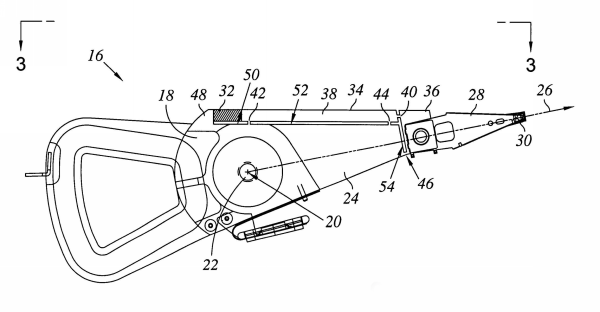
Schematic of a two-stage actuator (from United States Patent 6624983)
⇡ WD Black and terabyte plates
3DNews : Tell us why the series discs W.D. Black show such impressive performance, especially in random access tests?
Alex Blackwell: One of the foundations of high productivity is spindle speed. The second basis is a fast actuator, which reduces the search time for a track. The WD Black and RE series drives use two large magnets in the actuator motor. A stronger magnet allows the heads to move faster. The other series, Blue and Green, use a more compact single magnet, so the Black is ahead of the Blue in random access speed, although the latter also operate at 7200 rpm.
3DNews : When will the discs appear? W.D. Black with 1 TB platters?
Alex Blackwell: It's a matter of priorities. There is no technological reason why we can't do this. Terabyte plates are already used in the “green” series with a volume of 1-3 TB, in the “blue” series. You see, when you design a hard drive and want to sell it at a profit, you need to combine many parameters: performance, volume, yield of suitable components during production, and many others. It is a combination of factors that is important, not just having a certain technology. I believe that for WD Black terabyte plates simply have not yet reached the zone of optimal combination of characteristics.
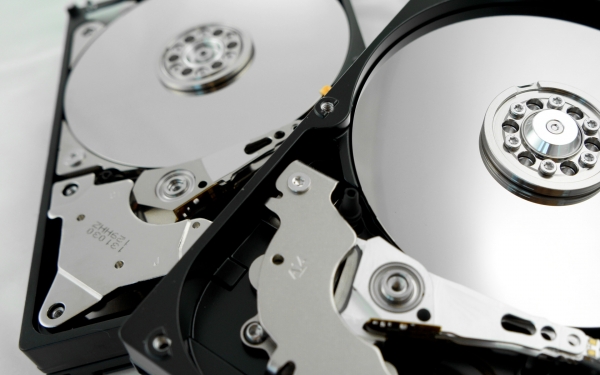
⇡ How the heads are arranged
3DNews : What are type heads? GPP / GMR (Perpendicular to Plane / Giant Magnetoresistance) that are used in hard drives today? How do they work?
Alex Blackwell: The original IBM hard drive and all subsequent drives up until 1996-1997 had single read/write heads. This head is a torn ring with a wire wound on top. When current is applied to the wire, a magnetic field is created that “leaks out” through the gap in the ring. If you bring a break close to something that can be magnetized, it becomes magnetized. This is what happens to the surface of the platter in a hard drive: areas appear that have magnetic poles - north and south. At the same time, if you do not apply voltage to the head, but simply move it along the magnetized area, a current arises in it.
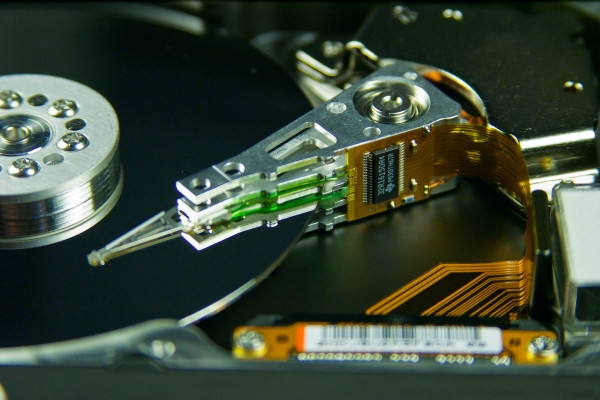
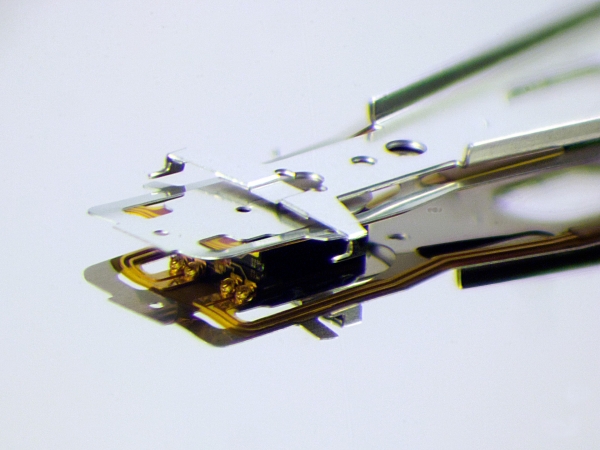
The actuator and its tip under a microscope (thanks to Andrew Hazelden, www.andrewhazelden.com for the photo)
Over time, it became obvious that a single device represented a compromise. What is good for writing may not be optimal for reading. Then the idea of magnetoresistance found application. A resistor was used as a read head, which changes resistance in the presence of a magnetic field. And as a recording head there is a separate inductive part. And no more compromise. Later, the second generation of this technology appeared - GMR (Giant Magnetoresistance), where Giant indicates the amount of voltage that allows the resistive element to develop. He just became more sensitive. And for the future after GMR, we have this thing: TuMR - Tunneling Magnetoresistance, which will further increase the efficiency of the head.
Now about the recording. The coil with a break in the middle, which I spoke about initially, is used for so-called longitudinal magnetic recording. Magnetized areas on the plate are formed in a longitudinal orientation. Just like cars park on the street.
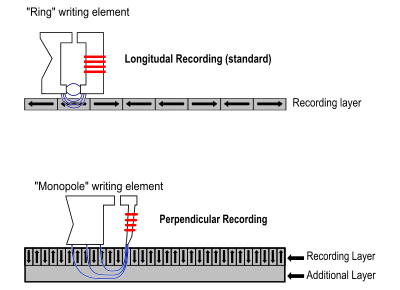
Longitudinal and perpendicular recording
But now we take and install these magnets vertically. This results in a perpendicular record. Without knowing the technology, it is difficult to imagine how this is done. In fact, you need to add another layer to the magnetic plate, which, as it were, reflects one of the poles of the coil and creates a weak magnetic effect distributed over a large area. This is how perpendicular recording works. It would also be better for cars to park vertically, especially in Moscow. The main thing is to remember to remove the coffee from the cup holder.
⇣ Contents
25.06.2005
The substrate material from which the wafer is made forms the basis on which the data will be stored. The data storage layer is a very thin coating of magnetic material on the surface of the platter. The thickness of this layer is several millionths of an inch.
The magnetic material used in older hard drives was an oxide material, namely iron oxide. If you look at the platters of old hard drives, they will have a characteristic light brown color. The type of magnetic material used in older hard drives is similar to the material used in audio cassettes: they also use iron oxide as a storer and carrier of sound information, which is why the film in audio cassettes is also light brown.
The oxide material was not expensive to use, but it had some disadvantages. The first disadvantage is that it is a soft material, and can be easily damaged by contact with the read/write head. The second drawback is that this material is only suitable for relatively low recording densities. Iron oxide worked well in old hard drives, where there was a low recording density, but while the developers increased and increased the recording density per unit surface, it became clear that this material was no longer able to cope with the task of storing information correctly and without problems.
Today's hard drives use thin film coating. As the name suggests, a very thin layer of magnetic material is attached to the wafer substrate. In the production of such plates, special production technologies. One of the technologies is electroplating. Another technology is spraying. Plates produced by sputtering technology have better uniformity than plates produced by electroplating. Due to increased requirements for the quality of platters in modern hard drives, platters produced using magnetic material deposition technology are used.
Compared with oxide material, thin film material is more uniform and smooth. It also has much better magnetic properties, allowing much more data to be stored per unit surface area. In addition, this material is much more resistant to physical influences.
After applying magnetic material, the plates are covered with a thin protective layer, consisting of carbon. In the end, the resulting “sandwich” is coated with a very thin layer of lubricant. This material is used to protect plates from accidental contact with magnetic heads, minimizing the consequences of such accidents.
Currently, developers at IBM are working on an experimental promising material that will replace thin-film coating in the future. Instead of a metal film sprayed on the surface, a composition of organic molecules and particles of iron and platinum will be used. This composition will be sprayed onto the plate, after which the plate will be heated. As a result of this procedure, particles of iron and platinum form a crystal lattice. IBM calls this structure a “nanocrystalline spatial lattice.” This technology has the potential to increase surface recording density by 10-100 times! Of course, this technology will require changes to other parts of the hard drive, especially the read/write heads and servo system.
The picture below is a photograph of two 5.25" plates: the top one with thin film coating, and the bottom one with iron oxide. Thin film plates reflect light very well. If you photograph such a plate at a right angle, it will be similar to trying to photograph a mirror. That's why For this reason, companies present photographs of their hard drives taken from a certain angle.



